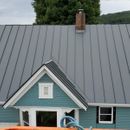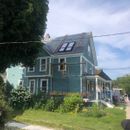Renovating attic to living space in 1850 Northern Vermont Home- venting and spray foam Qs
Hi,
I’m renovating my 1850 attic with a 12/12 pitch roof in Zone 6 to make livable space (master bed/bath)
Asbestos containing insulation was professionally removed from attic floor joists and new insulation is to be installed against roof.
I am planning a 1-1.5″ vent baffle against sheathing. Rafters are 6″ deep, with rafter bays 20″ wide. Planning to add furring strips perpendicular across rafters to allow spraying full 7″+ depth over baffles and cover rafters with at least 2-3″ of spray foam (avoiding heat loss strips at rafters). Goal is to get R49 roof or better.
Roof is in process of being replaced; standing seam with ridge vent (dormers have ridge vent too) I know it would have made long term sense to add two layers of foam on top of sheathing. Cost was an issue. Also, with roofers so backed up in this area I had to make commitments last spring to ensure I would be able to close up before winter.
Unico HVAC heating/cooling system to be installed so ERV should ensure no interior humidity issues.
Will replace the existing 2″ softet holes spaced ~24″ OC with a continuous softet vent strip.
Any feedback or tips for this plan are hugely appreciated.
What is minimum depth recommended for baffles? Could 1″ work?
Rafters are structurally sound but somewhat uneven in spacing because of house movement over the years (19-21″ in spots). Is there a baffle that is easier to work with with such inconsistency? Should I just onsite build with cardboard or filter fabric?
Thanks!
Attached is a picture from inside the attic of the two Velux windows that we’re really excited about for this space, as well as new metal roof in process.
GBA Detail Library
A collection of one thousand construction details organized by climate and house part












Replies
Brendan,
I'll give your post a bump. I read several times that a 2 inch vent space is best but 1.5 inches seems to be acceptable. For venting to work, the rafter bays should be open from the soffit to the ridge (and I don't see a ridge vent in your photo). Maybe you can ask the roofer to address this.
GBA increasingly advocates for avoiding spray foam, but it might make more sense to skip the venting and simple fill the bays with insulation. You could flash and batt to save costs. (See https://www.greenbuildingadvisor.com/article/flash-and-batt-insulation for more info.) In CZ6, you would need R-25 of closed cell against the sheathing and then the rest can be air permeable insulation.
You have options, I think. But let's see if an expert will weigh in.
Hi Steve, Thanks for your reply. Roof is actually in process of install now. One side done, other side with a couple skylights done this upcomming week. But good eye for the lack of ridge vent cap.
I understand the push to avoid spray foam. Just don't think I have the rafter depth for such a cold environment to do anything else. The article you referenced really makes me wish I had gone with above sheathing insulation...
> Could 1″ work?
FWIW, code says yes. IMO, it's adequate with excellent interior side air sealing and a steep roof.
As Steve said, venting (for moisture) isn't needed with enough CC spray foam. Venting can still be useful for ice dam reduction.
> Goal is to get R49 roof
Ignore the claims and figure about R5.6/inch for the long term R value of CC spray foam.
Consider adding rigid foam on the interior (vs perpendicular furring strips). Also consider cellulose (vs spray foam) between the rafters - it might be better for the environment and your finances despite the lower R value.
Jon,
Keeping baffle to 1" definitely has appeal for gaining more insulation depth. Goal is definitely to avoid ice damns because of high snowfall for the area.
I really like the idea of continuous rigid foam instead of furring strips. Then just go right over the rigid insulation with strapping for for drywall?
Thank you for your reply.
Be careful when mixing multiple vapor barrier layers with air gaps. Adding rigid over the rafters creates this in-between space that can get within condensation temperature range and have very little drying ability.
The better option is to go with either fluffy insulation or open cell SPF over the closed cell foam. Since you have uneven spacing, batts will be difficult, but you can dense pack. With older houses and complicated roof shapes, lot of times it is just simpler to go all SPF.
Your idea of cross strapping is the way to go as it not only gets you 16"OC spacing but it also lets you shim the surface flat.
Most people assume that spray foaming a place makes it air tight by default. SPF does help to seal a place up but lot of times you can still have some pretty large leaks. It is important to find these and seal them up. With 1/2 story construction, make sure to carry the SPF down all the way to the ceiling bellow. Do a blower test to verify, you can do a decent DIY blower door test with a box fan taped into a window.